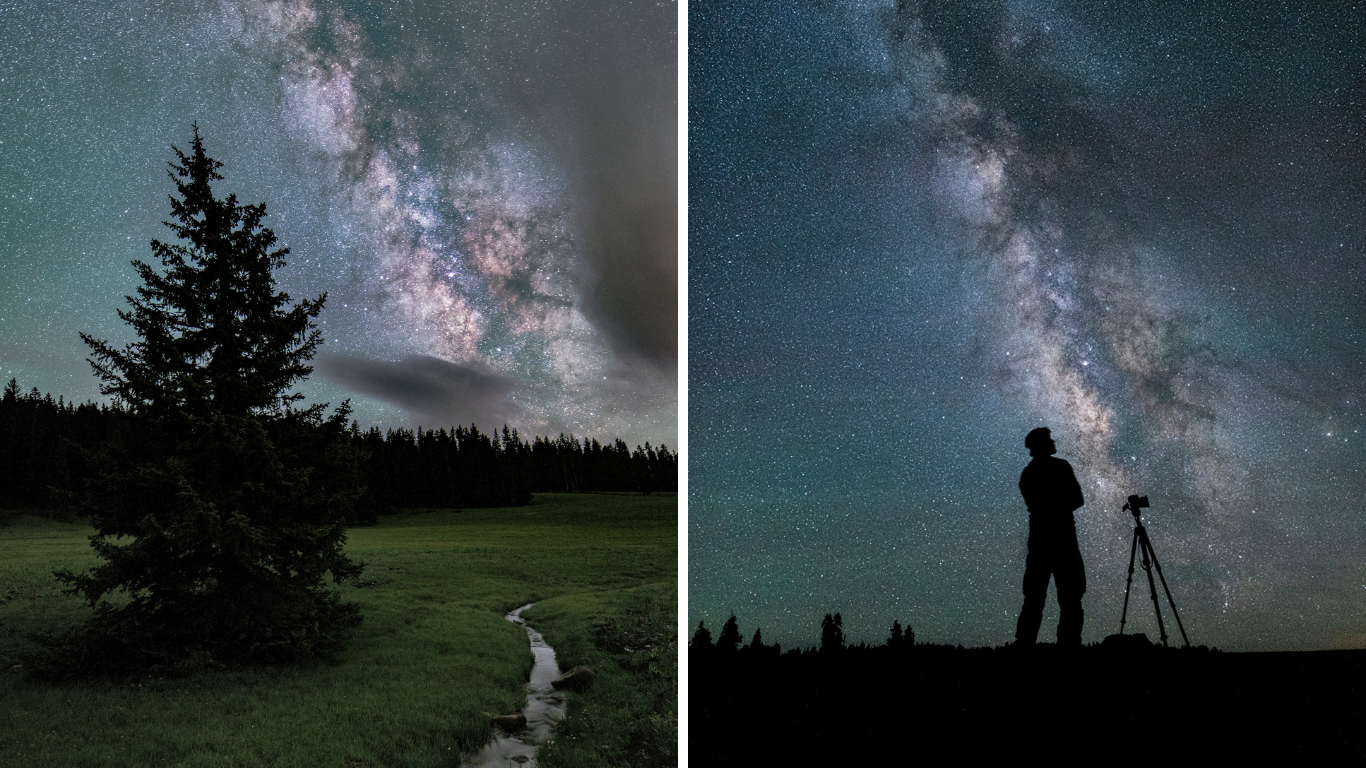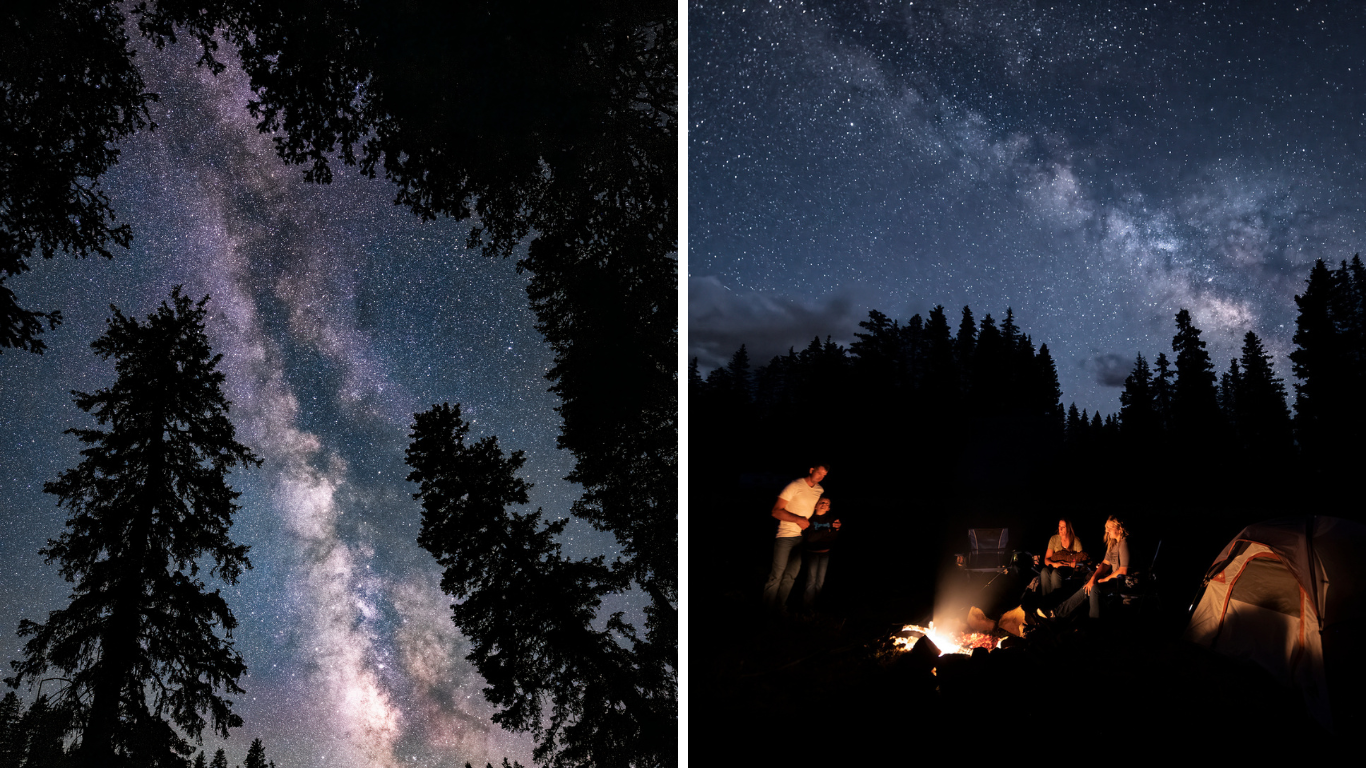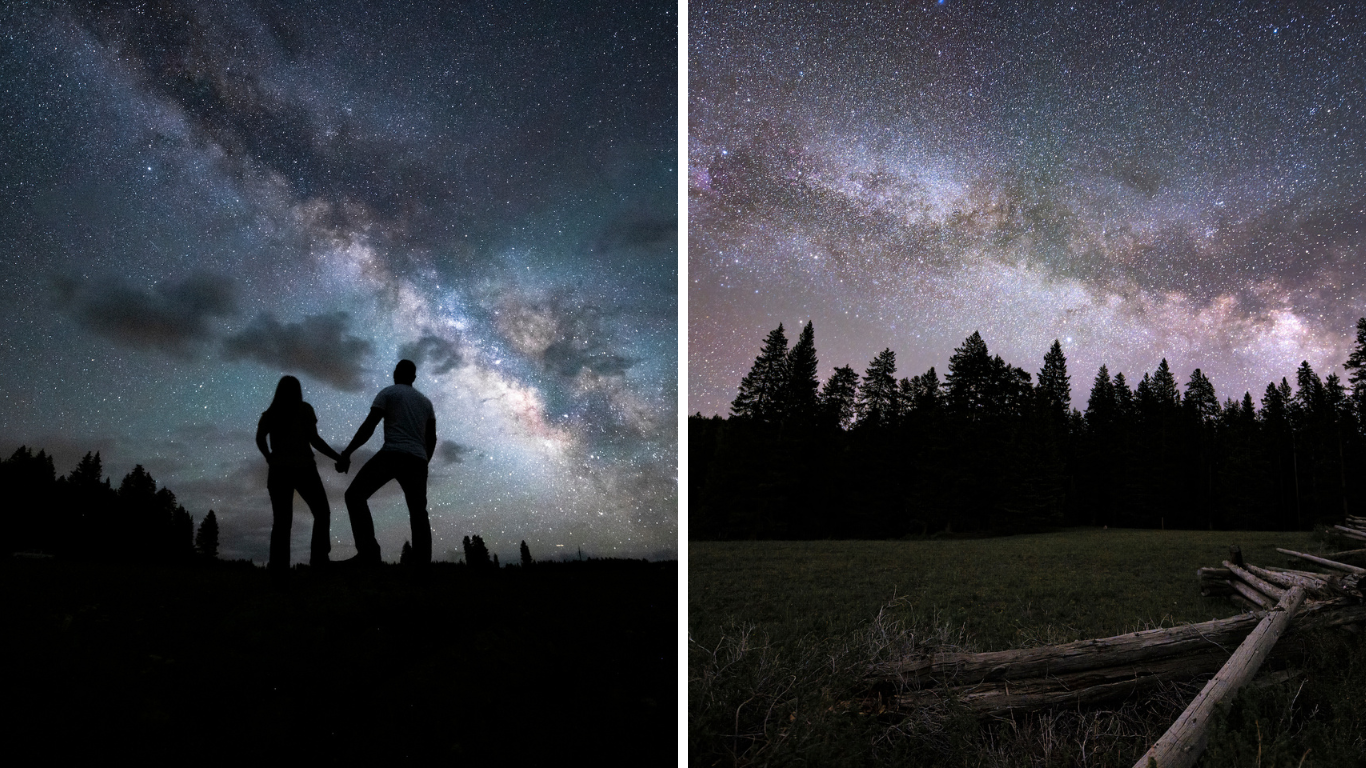See the Rugged Skies
With its high elevations and low humidity, Utah is home to some of the best stargazing in the country. Here in the remote darkness, the night skies open up to an extraordinary expanse of constellations, just waiting for people of all ages to witness. Check out the best spots to stargaze in Beaver County, Utah and how to prepare for a night under the stars.
Where to Stargaze in Beaver County
Eagle Point
At 10,000 feet, Eagle Point Resort is your gateway to gazing at other galaxies. For the same reason some of our most powerful telescopes are perched on top of mountains, the Tushar Mountains’ low humidity and dew point plus less air between you and the stars creates better viewing conditions and less atmospheric distortion. The resort’s limited, low-profile lighting further reduces the chance of light pollution, allowing the stars of the show to shine bright.
Puffer Lake & Big Flat
For lakeside viewing, head to Puffer Lake. This 65-acre alpine lake is located two miles past Eagle Point Resort on Highway 153. For an easy ‘two-for-one’ viewing of the stars, check out Big Flat, just 10 minutes past Puffer Lake via a gravel road. Big Flat is a premier stargazing location in the United States where 360 views provide a sense of awe you will never forget. You’ll find no light pollution here as the closest town is miles away. There are pull-out grassy areas that can be accessed for overnight camping where you can gaze the night away.
Three Creeks Reservoir & Strawberry Flat
Three Creeks Reservoir and adjacent Strawberry Flat are less-traveled, though no less wonderful. Discover these gems by turning off Hwy 153 just before hitting Eagle Point Ski Resort. Now that you’re on a gravel road, a four-wheel-drive vehicle is advised but not required during the summer months. Take a lawn chair and find a comfortable spot at Strawberry Flat. The skies here are so dark, the stars will alarm you with how bright they show up.
Big John Flat
3.5 miles down a gravel road, you’ll discover Big John Flat, a popular camping area among locals and visitors alike. Fall in love with the area’s large grassy meadows, which offer access to Delano Peak—Beaver County’s highest peak. If you hike to the top of Delano before dusk and stay high on the peak, you’ll have access to the region's highest views, which are bound to bring stargazing to a whole new level.
Rock Corral
Rock Corral Recreation Area is located on the eastern side of Beaver County in the Mineral Mountains. This area has pit toilets for convenience and is in a very remote, non-popular area. The granite peaks that are typical in these mountains surround you and loom into the night sky as you gaze skyward, adding a different view and perspective that is incredible to behold.

Getting Started with Stargazing
- Choose your stargazing spot. Lucky for us, Beaver County has a lot of great places to stargaze, most notably the five we highlight here. Choose from Eagle Point, Puffer Lake and Big Flat, Three Creeks Reservoir and Strawberry Flat, Big John Flat, or Rock Corral.
- Invest in a red flashlight. After giving your eyes 15 minutes to adjust to the darkness, use a flashlight with red light. Red light has a different effect on your eyes so they won’t have to get accustomed to the dark every time. Alternatively, you can also wrap some red cellophane over a regular flashlight.
- Don’t buy a telescope (yet). There’s quite a lot to see with your naked eye. But, if you’re ready to take your stargazing up a notch, a good set of binoculars will go a long way to seeing the moon, planet, and some deep-sky objects. If you’re still interested in pursuing more detailed stargazing, then it might be time to invest in a telescope.
- Know when to look. The best time to go stargazing is the days before, during, and soon after each new Moon, when there is no Moon in the sky.
- Get a star chart or app. There are loads of apps out there that will tell you which constellations are in the sky and where. All you have to do is hold up your phone to the night sky and it will tell you exactly what you’re looking at. We recommend the following apps:
- Learn the difference between planets and stars. The simplest way to differentiate between planets and stars is by observing whether the object is twinkling or if it remains bright. Stars twinkle while planets are brighter and do not shimmer.
- Use a calendar. Check out an astronomical calendar for celestial activity. The night sky is constantly changing, depending on the time of year and the time of night. Try stargazing at different times in the year to spot seasonal constellations.
- Make the most of clear nights. The only challenge for astronomy is the clouds. Cloudy nights are the ultimate enemy, so make sure to make the most of clear skies for the best stargazing.
- Look for these constellations:
- Orion (the hunter), with belt and sword, is one of the most famous constellations and one of the few that genuinely bears a resemblance to its namesake.
- Leo (the lion), is one of the easiest constellations to spot—although it looks absolutely nothing like a lion
- Ursa Major (the Big Dipper), is visible all year in the northern hemisphere. It looks like a cup with a long handle.
- Cassiopeia (the queen of Aethiopia), is named after a vain queen who boasted about her unrivaled beauty. Looks like a giant 'W' shape.
- Hydra (the water snake), is the largest and longest constellation in the night sky. It looks like a sea serpent.
- Stay warm. It can get chilly at night, especially up in the Tushar Mountains. Pack blankets, sleeping bags, warm coats, and hats to make your stargazing experience more comfortable.

FAQs
From the darkest corners of the state’s remote, natural areas to the unique observatories in towns of all sizes, Utah is simply one of the best places in the country for people of all ages to witness and learn more about the incredible science of astronomy.
Much of this has to do with Utah’s low humidity, the amount of national and state forest land, and the number of places located at high elevations. Because of this, Utah currently claims 24 of the world’s 196 International Dark Sky Places (the highest per state in the country!), which are broken down into categories with varying requirements for certification by the International Dark-Sky Association.
An astronomical calendar can tell you when to look for meteor showers, when planets are closer to earth, and more.
This interactive sky chart will help determine which constellations to look for.
A star is a gigantic, luminous ball of heated gas, or plasma, held together by gravity. They are formed mainly of hydrogen and helium.
There are multiple stars for every grain of sand on Earth. A rough estimate says there are 5 to 10 times more stars in the universe than grains of sand on all the world’s beaches.
The coolest stars in the sky are red, while the hottest stars are blue. Seems counterintuitive, but blue light (shorter wavelengths) is more energetic than red (longer wavelengths), and therefore hotter.
The twinkling of stars is caused by the instability of our atmosphere. As the starlight passes through the atmosphere, the movement of the air bends the light slightly and makes the stars twinkle.
The brightest star visible in the night sky is Sirius, located in the constellation Canis Major.
Constellations are arbitrary groupings of stars that seem to form pictures. Ages ago, ancient people looked up at the night sky and thought they could see patterns. Since different constellations are visible at different times of the year, people used these patterns to tell what time of the year it was.
Today, we divide the sky into 88 different constellations. Every star or other object in the night sky falls into one of these 88 constellations.
This question gets asked a lot. The blue color of the sky during the day is caused by scattered sunlight. The white light from the Sun is composed of all the colors of the rainbow. During the day, the molecules in the air scatter the blue light from the Sun more than the red light making the sky appear blue.
The Moon shines because the light from the Sun shines and reflects from the Moon’s surface. What we think of as Moon shine is just reflected sunlight.
The Moon goes through phases because it is traveling around the Earth. One-half of the Moon is always illuminated by the Sun. As the Moon circles the Earth, different amounts of the illuminated part of the Moon are facing us.
A meteor shower is an event where many meteors appear to radiate from a common point in the night sky. The meteors are caused by streams of debris left over by comets. This debris is usually no larger than a grain of sand. As the debris enters the Earth’s atmosphere at a high rate of speed, the friction causes the gases to glow. This glowing trail of ionized gas is known as an ionization trail.
Comets are relatively small solar system bodies composed of ice and dust. Due to this unusual composition, many astronomers call them “dirty snowballs”.
Stargazing Etiquette
While stargazing in Beaver County, we ask that you follow a few rules so the experience is enjoyable for you, your neighbors, and those who call Beaver County home.
Light
It takes time for your eyes to adjust from a light-filled space to a dark one. This is especially true while stargazing. Your eyes need time to adjust to the truly dark sky and see all the stars possible. In fact, it can take up to forty minutes for the eyes to reach ideal dilation for casual stargazing, and it only takes a quick flash of bright light to blow out everyone’s night vision.
Phones are the biggest offender when it comes to light while stargazing. Even the screen of your phone puts off enough light to ruin the experience. Other offensive lights include handheld flashlights and headlamps. Do yourself and your fellow stargazers a favor and keep those phones and lights tucked away. If you need your phone for a stargazing app, be considerate and step away from the group.
One exception can be red lights, which pro stargazers keep on hand to help find their way around in the dark. Red flashlights can be purchased ahead of time. Wrapping red cellophane over a regular flashlight works too.
Noise
Seeing a truly dark sky and the stars that come with it is awe-inspiring, and it deserves so reverence. So, remain quiet and soak in the moment.
Waste
Leave No Trace is a group of principles that encourages visitors to leave environments as they find them, to respect nature, and to be kind to each other. A very important Leave No Trace principle is to properly dispose of waste. In Beaver County, we encourage visitors to ramble responsibly, and while stargazing, we want to emphasize taking all of your waste with you. It's easy to miss trash and any other piece of personal property when it's so dark outside. Please bring the minimum with you so you don't leave any waste behind and take time to carefully look all around you before you leave.

Stargazing Health Benefits
A Reason to Get Into Nature
It's well known that getting into nature is great for your mind and body, and to get a great glimpse of the stars, you have to get away from cities and larger towns and get into nature. According to one Finnish study, spending just 15 minutes sitting in nature can help us to feel psychologically refreshed, while multiple studies have linked nature walks with improved mental health.
Relieve Stress
Stargazing is a great way to unwind and relax. It has been proven to help clear the mind, lower blood pressure, reduce stress, and improve sleep quality. Staring at the stars provides a natural reprieve from the everyday stresses of modern life. So whether you want to take a break before heading home or find some peace in your busy day, it’s time to try stargazing.
Be Kinder
A University of California-Irvine study found that looking up at the stars makes us kinder because it helps us feel diminished in the presence of something greater than ourselves. Gazing at such an immense sky and the stars in it make us realize how insignificant we, and our problems, are. When this happens, we tend to become more understanding, compassionate, and patient.
Ignite Your Creativity
In the stillness and quiet that comes when stargazing, your conscious and mind quiet and your subconscious mind comes to life. This is where your ideas come from. It's the same as getting great ideas when on a walk or in the shower. It's in that state of minimal distractions that our creative energies flow.
Be Social...or Not
Stargazing is a great social activity because anyone can do it—literally. Bring your friends, your family, or your colleagues. It's a great way to spend time together. Or, if you're aching for some alone time, head out on your own, look up, and enjoy all the health benefits that come from stargazing.


